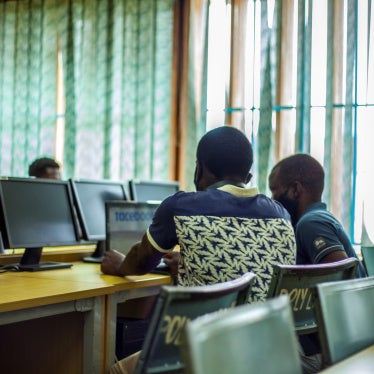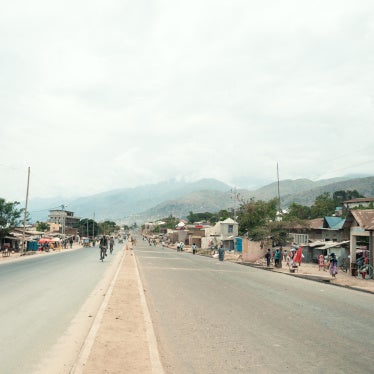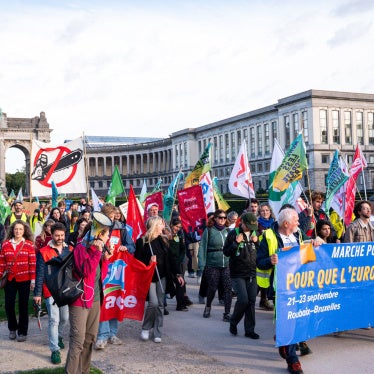The Kenyan authorities should halt their plan to forcibly move 55,000 registered refugees and asylum seekers from cities to overcrowded and underserviced refugee camps, Human Rights Watch said today. Citing a number of grenade attacks in 2012, the authorities contend the move will improve Kenyan national security and lead to the return of Somali refugees to Somalia.
The plan would violate refugees’ free movement rights and would almost certainly involve the unlawful forced eviction of tens of thousands of refugees from their lodgings in the cities, Human Rights Watch said. The longstanding humanitarian crisis in Kenya’s refugee camps also means the relocation would affect refugees’ ability to make a living and unlawfully reduce their access to adequate food, clothing, housing, health care and education.
“Kenya is using the recent grenade attacks to stigmatize all refugees as potential terrorists and to force tens of thousands of them into appalling living conditions in already severely overcrowded camps,” said Gerry Simpson, senior refugee researcher and advocate for Human Rights Watch. “The plan to forcibly transfer tens of thousands of people from the cities to camps is unlawful and will cause extreme hardship.”
In a December 13 news release, the Kenyan authorities said the transfer of urban refugees to the camps responds to a series of attacks in which unidentified people threw hand-grenades into crowds in various locations, killing and injuring a number of people, including police officers and soldiers.
On January 16, 2013 the Ministry of Provincial Administration and Internal Security wrote to the Ministry of Special Programs saying the first phase of “rounding” up refugees would “target” 18,000 people and would start on January 21. The letter said they would be taken to Nairobi’s Thika Municipal Stadium, which would act as a “holding ground” pending transfer to the camps.
Organizations and lawyers working with refugees in Nairobi say that since December, police in Nairobi have arrested dozens of Somalis on spurious charges of belonging to terrorist organizations. All of those taken to court have been released for lack of evidence.
In May, Human Rights Watch reported on serious abuses by security officers in northern Kenya against civilians following some of the grenade attacks that killed security officers. In response to the report, the Kenyan military promised to end such violent reprisals and formed a committee to investigate the abuses. Human Rights Watch is concerned that security forces would again use violence while arresting and forcibly transferring refugees to the camps.
The plan, if implemented, would violateKenya’s international and national legal obligations, Human Rights Watch said. These obligations require Kenya to show that any free movement restrictions must be the least restrictive measure possible to address Kenya’s national security concerns.
Human Rights Watch’s June 2010 report, “Welcome to Kenya,” concluded that Kenya’s requirements that half a million refugees live in closed camps -- which only a few thousand may temporarily leave each year under special circumstances -- violated its legal obligations to guarantee refugees’ freedom of movement.
“Kenya’s plan to move 55,000 refugees into camps is clearly an unnecessary and disproportionate response to the recent attacks,” Simpson said. “Kenya should not just brand all refugees a security risk and walk all over the rights of 55,000 people.”
According to the United Nations High Commissioner for Refugees (UNHCR), at the end of 2012, 46,540 registered urban refugees were living in Kenya, including 33,246 Somalis. In addition, 6,832 registered urban asylum seekers from a variety of nationalities, including 447 Somalis, were living in Kenya.
On December 13, Kenya’s Department of Refugee Affairs (DRA) released a press statement to the news media announcing the authorities’ plan to “put in place a structure encampment policy” because of an “unbearable and uncontrollable threat to national security” caused by “grenade attacks in our streets, churches, buses and business places” that have “killed and … injured … many people.”
It said that all asylum seekers and refugees from Somalia in Kenya’s urban areas should move to the Dadaab refugee camps near the Somali border and that all urban asylum seekers and refugees from other countries should move to the Kakuma refugee camp, near the Sudan border. It said thatregistration of asylum seekers and refugees in urban areas had been stopped, that all registration centers had been closed and thatUNHCR and other agencies serving asylum seekers and refugees should stop providing all direct services to refugees.
At a December 13 news conference, Kenya’s acting commissioner for refugee affairs, Badu Katelo, said that urban refugees’ and asylum seekers’ “documentation has ceased to function in the urban areas and if they will continue staying in the urban areas they will be staying illegally -- and that [arresting and removing them from the cities] is a function of another department of government, probably police and immigration.”
Since December, UNHCR and other organizations have asked the Kenyan authorities for a copy of the directive on which the December 13 news media statement is based, but the authorities have refused to issue a copy.
Since the plan was announced, non-governmental organizations and refugee lawyers in Nairobi say the police in Nairobi have arbitrarily arrested hundreds of Somali nationals, most of whom have been released after paying hefty bribes. Reports from the Somali Embassy in Kenya, airline companies and aid workers on the Kenya-Somali border near the Dadaab camps say that since December over a thousand Somalis have returned to their country every week, either by air or overland. Some told aid workers in Somalia they left because they feared a crackdown against Somali refugees in Kenya.
Human Rights Watch has also received reports of a significant increase since late December in sexual violence against refugee women and girls in one of the Dadaab camps, “Ifo 2.”A reliable source told Human Rights Watch that the police have failed to respond adequately to the attacks, which refugees say has led to a general fear of insecurity that has caused hundreds of refugees to leave the camps and cross into Somalia. Others have relocated to the edge of other camps near Dadaab. In 2010, Human Rights Watch reported on longstanding Kenyan police failures to investigate sexual violence in the Dadaab camps.
At the December 13 news conference, Commissioner Katelo said that the refugees’ relocation to the camps would “closely be followed by repatriation of Somali refugees back to Somalia.” On December 21, President Mwai Kibaki said that, “There is no dignity in living in refugee camps” and that Somalia and Kenya would “work together to enable the hundreds of thousands of Somalis who are living in refugee camps to return to their homes.”
Human Rights Watch said the situation in south-central Somalia remains insecure and that any steps by Kenyan authorities to force or otherwise encourage Somalis to return to their country would breach Kenyan and international law, which forbids the forcible return of refugees to persecution, torture, or situations of generalized violence.
The ongoing humanitarian crisis in the Dadaab camps – where at least 450,000 refugees are crammed into space meant for 170,000 -- and the lack of properly developed new camps there or near the Kakuma camps means any transfer of refugees from the cities to the camps would also breach Kenya’s international legal obligations. They require Kenya not to adopt “retrogressive measures” that would negatively affect refugees’ rights to adequate standard of living -- including food, clothing and housing -- and to health and education.
On December 28, Doctors Without Borders, which runs numerous health care programs in the camps, said that in light of “completely overstretched assistance” in the camps, the “medical and humanitarian situation” of the refugees in Dadaab was already “disastrous,” “dire,” and “precarious” and that the organization was “concerned about the medical consequences [of] a new influx of refugees” on the camp population.
Human Rights Watch also said that arbitrarily forcing tens of thousands of people out of their homes in the cities would amount to forced evictions, unlawful under international law.
Human Rights Watch called on foreign donors to Kenya and on UNHCR to oppose the relocation plan, based on its inevitable violation of refugees’ rights to free movement, basic social and economic rights, and the right not to be forcibly evicted.
“This plan would ride roughshod over a range of refugees’ fundamental rights and enforcing it could well precipitate the very insecurity Kenya says it’s trying to prevent,” Simpson said. “Foreign donors to Kenya and UNHCR should encourage Kenya to abandon the plan.”
For more details about the ongoing humanitarian crisis in Kenya’s refugee camps and how the plan would violate Kenya’s international legal obligations if implemented, please see below.
To read the June 2010 Human Rights Watch report, “Welcome to Kenya: Police Abuse of Somali Refugees,” please visit:
https://www.hrw.org/reports/2010/06/17/welcome-kenya-0
To read the March 2009 Human Rights Watch report, “From Horror to Hopelessness: Kenya's Forgotten Somali Refugee Crisis,” please visit:
https://www.hrw.org/reports/2009/03/29/horror-hopelessness
To read the May 2012 Human Rights Watch report,“Criminal Reprisals: Kenyan Police and Military Abuses Against Ethnic Somalis,” please visit: https://www.hrw.org/news/2012/11/22/kenya-end-security-force-reprisals-north
For more reporting on Kenya’s treatment of Somali refugees, please visit: https://www.hrw.org/africa/kenya
Ongoing humanitarian crisis in the Dadaab and Kakuma refugee camps
Human Rights Watch said Kenya’s refugee camps – Dadaab and Kakuma – are unsuitable for relocating refugees from Kenya’s cities. Since 2007, the Dadaab camps, which UNHCR says have a capacity for 160,000 people but shelter at least 450,000, have faced a permanent humanitarian crisis. UNHCR says that of the refugees in Dadaab, 96 percent are Somalis and that the Kakuma camp is almost 10,000 over capacity.
In March 2009, Human Rights Watch reported on the humanitarian crisis in the three refugee camps near the town of Dadaab in Kenya’s North Eastern Province, which although designed for only 90,000 refugees were then sheltering 250,000. In 2009, UNHCR appealed for US $92 million to run the camps but received a little over a third of that amount. Since then, the number of registered refugees in the two-decade-old camps has doubled: as of early January 2013, 450,000 refugees in Dadaab were living on land officially approved for around 170,000 people. Aid agencies working there say the camps have lurched from one crisis to the next. UNHCR’s budget remains chronically under-funded.
In an attempt to decongest the old camps, in mid-2011 the Kenyan authorities opened a fourth camp – Ifo 2 – which is sheltering 70,000 people, 10,000 short of its capacity of 80,000. Due to lack of space, tens of thousands of refugees continue to live outside the official confines of the four camps, where they struggle to access even the most basic services.
Since mid-2011, some 18,000 refugees have also moved to a fifth site near Dadaab, Kambios. On January 18, UNHCR said the government had agreed to recognize Kambios as Dadaab’s fifth camp. Informally, the site has a capacity for 20,000 people. UNHCR says that if approved and properly prepared – at a cost of millions of dollars-- the camp could shelter 80,000 people. At full capacity, the camp would have annual operating cost of millions of dollars.
UNHCR says refugees in Kambios camp receive minimum of assistance, with no food distribution in the camp itself, and poor quality health care and education provided in makeshift structures. There is also no officially-approved market place to help refugees trade to supplement basic assistance and there is no police station.
The Kakuma camp in Turkana District, northwestern Kenya, is also over capacity, sheltering 107,205 refugees and asylum seekers in space meant for 100,000. Half are Somalis and 30 per cent are south Sudanese. Since early 2012, UNHCR has been negotiating with the authorities for approval to open a second camp nearby, in Kalobei. On January 18, UNHCR said the authorities had agreed that the camp should be built. UNHCR estimates it will cost $15 million to build a camp at Kalobei for 20,000 people and tens of millions more to increase its capacity to over 50,000 people and to maintain it every year.
Refugees’ free movement rights
Since the early 1990s, Kenya has adopted an informal policy requiring most refugees to live in refugee camps and restricting their movement to the limited confines of these camps. In June 2010, Human Rights Watch reported that the policy -- which now affects 560,000 refugees and asylum seekers in Kenya’s camps -- violates international and Kenyan human rights and refugee law guarantees of refugees’ right to move freely in their country of refuge.
Under international and Kenyan law, Kenya must formally justify any prohibition on free movement as the least restrictive measure necessary to protect national security, public order, or public health, which it has never done for the 560,000 people forced to live in Kenya’s camps. In addition, any such policy may not discriminate between Kenyan citizens and foreign nationals.
Human Rights Watch said that the authorities’ December 13 news release fails to show that the plan to force another 55,000 refugees living in Kenya’s cities into camps is the least restrictive measure to address Kenya’s national security concerns and clearly discriminates between Kenyan citizens and refugees because the policy allows Kenyans to move freely and denies refugees’ that right.
Refugees’ rights not to have their social and economic rights reduced and prohibition against forced evictions
Kenya is a party to the International Covenant on Economic, Social and Cultural Rights, which sets out the rights of everyone, nationals and non-nationals alike, to an adequate standard of living -- including food, clothing and housing -- and to health, and education.
The covenant -- and the committee that reviews compliance – says countries have “a minimum core obligation to ensure the satisfaction of, at the very least, minimum essential levels of each of the rights.” It also prohibits countries from carrying out “any deliberately retrogressive measures” – measures that deprive people of rights that they used to enjoy -- which breach countries’ obligation to “progressively realize” the rights in the convention.
Kenyan refugee organizations say many refugees who have lived for years or even decades in Kenya’s cities have found access to livelihoods, live in mostly adequate shelter, and largely have access to education and health care. Human Rights Watch said moving them into the overcrowded camps would clearly amount to “retrogressive measures” and would therefore violate Kenya’s obligations under the covenant.
The covenant’s compliance committee has said that article 11, which guarantees everyone the right to adequate housing, prohibits the forced eviction of people from their lodging. The committee defines “forced evictions” as “the permanent or temporary removal against their will of individuals, families and/or communities from the homes and/or land which they occupy, without the provision of, and access to, appropriate forms of legal or other protection.” Evictions are only lawful if they are carried out in a way “envisaged by law” and “relevant legislation must specify in detail the precise circumstances” in which such evictions “may be permitted.” Any such laws must be “in conformity with the provisions of” international human rights law.
Human Rights Watch said that because Kenya’s plan to relocate urban refugees could not be justified on national security grounds, any evictions carried out under the plan would not comply with international human rights law and would therefore amount to forced evictions.







